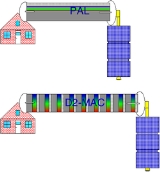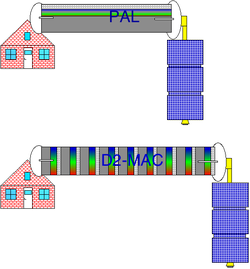
C-MAC
Encyclopedia


European Broadcasting Union
The European Broadcasting Union is a confederation of 74 broadcasting organisations from 56 countries, and 49 associate broadcasters from a further 25...
(EBU) for satellite transmissions. The digital information is modulated using 2-4PSK (phase-shift keying
Phase-shift keying
Phase-shift keying is a digital modulation scheme that conveys data by changing, or modulating, the phase of a reference signal ....
), a variation of quadrature PSK where only two of the phaser angles (±90°) are used.
- The data capacityChannel capacityIn electrical engineering, computer science and information theory, channel capacity is the tightest upper bound on the amount of information that can be reliably transmitted over a communications channel...
for C-MAC is 3Mb/s. - C-MAC data has to be sent to the transmitter separately from the vision.
- The transmitter switches between FM (vision) and PSK (sound/data) modulation during each television line period.
C-MAC variants : E-MAC
E-MAC (Extended MAC) is 16:9 version of C-MAC. Originally E-MAC was designed for 15:9 pictures, it later adopted the 16:9 aspect ratio.- In E-MAC all the 4:3 information is transmitted exactly as in C-MAC so that C-MAC receivers are still compatible.
- E-MAC hides extra luminance and chrominance information in the field blanking interval and parts of the line blanking interval.
- E-MAC has a lower data capacity because luminance is hidden where data would usually be located.
- A 'steering' signal is transmitted to indicate to the 16:9 receiver whereabouts the 4:3 picture information.
- E-MAC receivers stitch the 4:3 and helper wide-screen data into a seamless 16:9 picture.
MAC FAQ
MAC transmits luminance and chrominanceChrominance
Chrominance is the signal used in video systems to convey the color information of the picture, separately from the accompanying luma signal . Chrominance is usually represented as two color-difference components: U = B' − Y' and V = R' − Y'...
data separately in time rather than separately in frequency (as other analog television formats do, such as composite video).
Audio and Scrambling (selective access)
- Audio, in a format similar to NICAMNICAMNear Instantaneous Companded Audio Multiplex is an early form of lossy compression for digital audio. It was originally developed in the early 1970s for point-to-point links within broadcasting networks...
was transmitted digitally rather than as an FM sub-carrier. - The MAC standard included a standard scrambling system, Euro-Crypt, a precursor to the standard DVB-CSA encryption system.
See also
Web links:- Multiplexed Analogue Components in "Analog TV Broadcast Systems" by Paul Schlyter
TV transmission systems
- Analog high-definition television systemsAnalog high-definition television systemsHistorically, the term high-definition television was first used to refer to a analog video broadcast television system developed in the 1930s to replace early experimental systems with as few as 12-lines. On 2 November 1936 the BBC began transmitting the world's first public regular...
- PALPALPAL, short for Phase Alternating Line, is an analogue television colour encoding system used in broadcast television systems in many countries. Other common analogue television systems are NTSC and SECAM. This page primarily discusses the PAL colour encoding system...
& SECAMSECAMSECAM, also written SÉCAM , is an analog color television system first used in France.... - Multiplexed Analogue ComponentsMultiplexed Analogue ComponentsMultiplexed Analogue Components was a satellite television transmission standard, originally proposed for use on a Europe-wide terrestrial HDTV system, although it was never used terrestrially.- Technical overview :...
- DVB-SDVB-SDVB-S is an abbreviation for Digital Video Broadcasting — Satellite; it is the original Digital Video Broadcasting forward error coding and demodulation standard for satellite television and dates from 1994, in its first release, while development lasted from 1993 to 1997...
& DVB-TDVB-TDVB-T is an abbreviation for Digital Video Broadcasting — Terrestrial; it is the DVB European-based consortium standard for the broadcast transmission of digital terrestrial television that was first published in 1997 and first broadcast in the UK in 1998...

